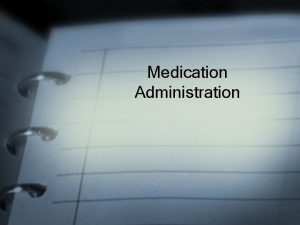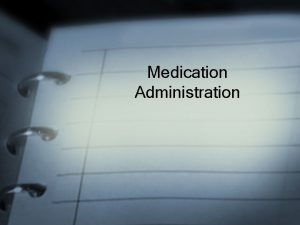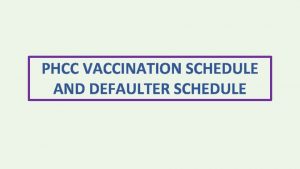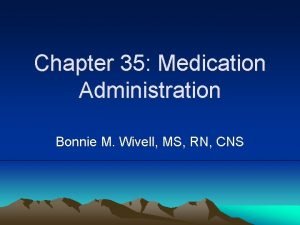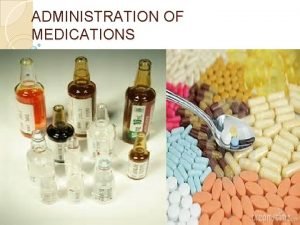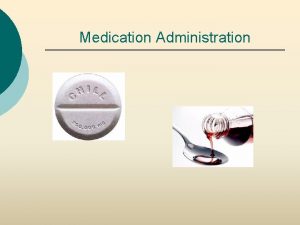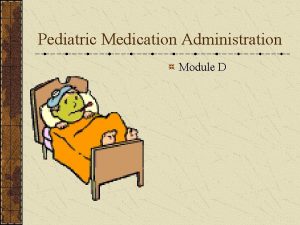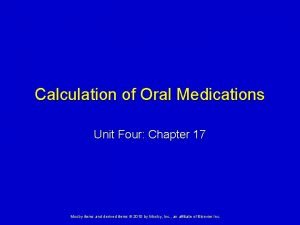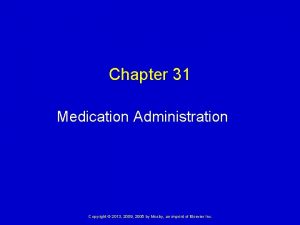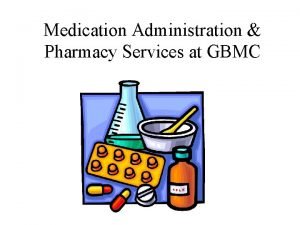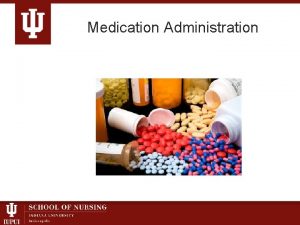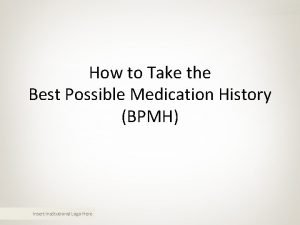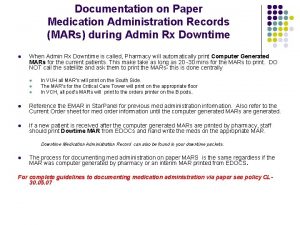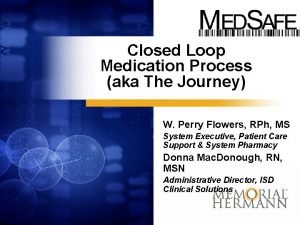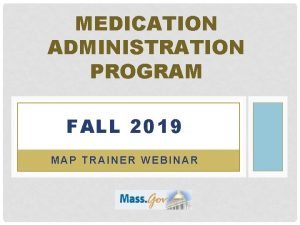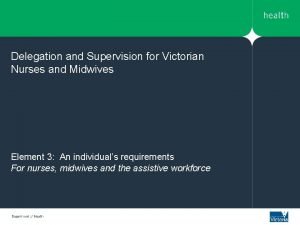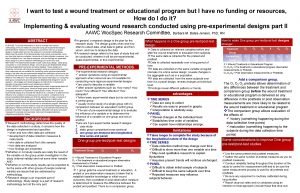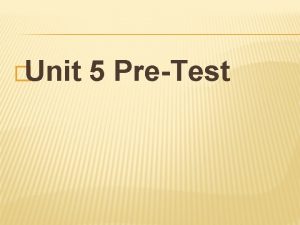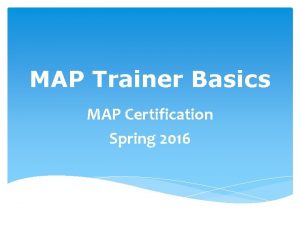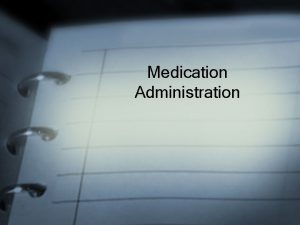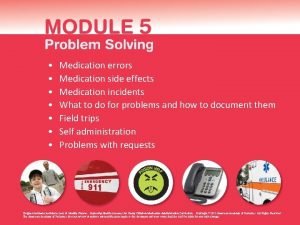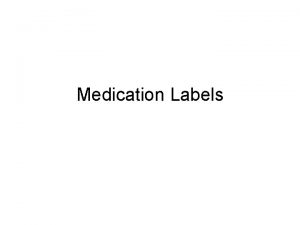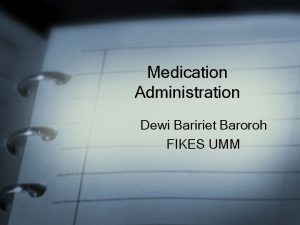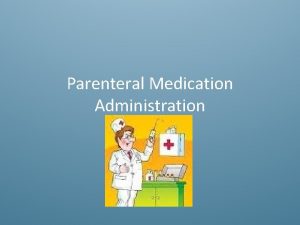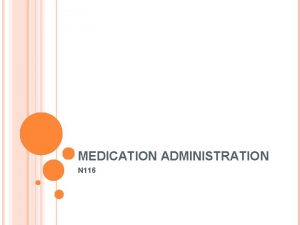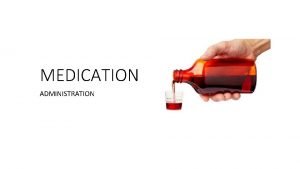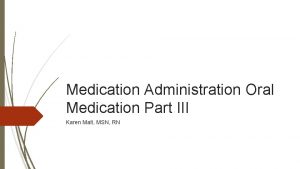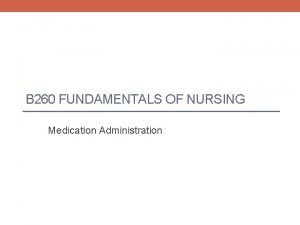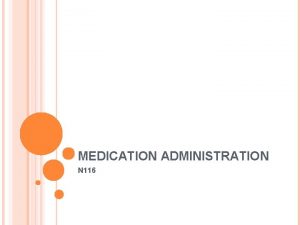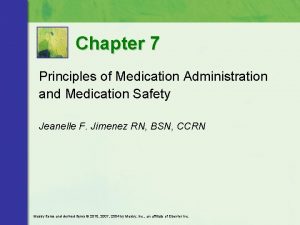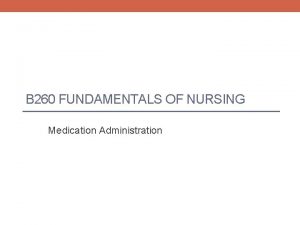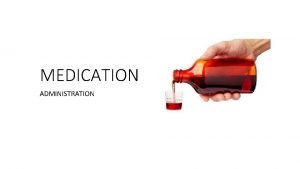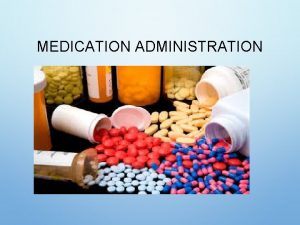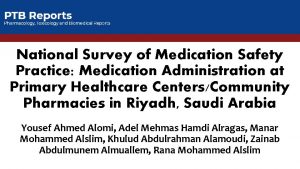Medication Administration Pretest 1 Name the five rights







































































- Slides: 71

Medication Administration

Pretest 1. Name the five rights 2. Name three types of injections we will talk about today.

Overview Medication errors is a serious problem: • 8 th leading cause of death in the US • 7, 000 deaths annually • 44% of errors occur during administration of medication Rich, V. (2005) How We Think About Medication Errors. American Journal of Nursing, supplement. Pg. 10.

Categories of Pharmacy • Pharmacognosy- study of characteristics of natural drugs and their sources • Pharmacodynamics- study of what drugs do to the body • Pharmacokinetics- what the body does to drugs (absorbs, metabolizes, distributes, and excretes). • Pharmacotherapeutics- study of how drugs are used to treat disease • Toxicology- study of poisonous effects of drugs

Sources of Drugs • Many drugs originate as natural products – Plants – Animals – Minerals – Bacteria or fungi

Medication Administration • • Medical Order Transcription What drug information is needed Planning/ Preparation Medication Administration Post Medication Administration

7 Components of a Medication Order Tammie Fae 3/15/07 0815 MR # 1974758 Toradol 15 mg IM prn pain --------------------Dr. Seuss

Frequency • Routine: administer as ordered until discontinued (BID, TID, QD) • One time only: administer one dose and then discontinue • Stat: administer immediately • PRN: as needed within the time interval given. Needs to have an indication stated in order.

Planning/ Preparation • Drug information – – – – Action Indication Normal dosage range and route Adverse effects Contraindication Drug interactions Nursing Considerations

Planning/ Preparation • Assessment information – – B/P (HTN med) Pulse (cardiac drugs like Digoxin) Pain rating (pain med) Temp (antipyretic) • Time Management – Plan to administer within ½ hour of scheduled administration time – Administration times are set by individual facility policies.

Controlled Substances • Medications that have a high abuse potential. There are laws and regulations to monitor the use of these medications. – Locked with limited access. – Inventory done by 2 nurses at set intervals. – Medication counted before removal and tally kept on separate document. – Waste of medications must be witnessed and documented by another nurse.

Medication Preparation • Wash hands • Assemble the medications in the medication room. • Remove the meds from the drawer – Check for drug expiration date – Check for the five “rights” against the MAR **Check drawers at the beginning of your shift in case any medications are missing, you can order them from pharmacy. NEVER “borrow” medications from other patient’s supply.

5 “Rights” • • • Right DRUG Right DOSE Right ROUTE Right TIME Right PATIENT

5 “Rights” • Right DRUG: – Compare drug to MAR three times • Taking out of cassette, in med room and at bedside – Note expiration date – Know indication and nursing considerations

5 “Rights” • Right DOSE: – Validate calculations of divided doses with another nurse – Check heparin, insulin and digoxin with another nurse – Know the usual dose and question any dose outside of safe range

5 “Rights” • Right ROUTE: – Right route or method of administration – If a change in route is needed, request new order from physician – Ex: Tylenol 650 mg suppository can not be changed to PO route without a new order.

5 “Rights” • Right TIME: – Medication given 30 minutes before or 30 minutes after time ordered is acceptable. – Refer to policy and procedure manual. – **Standard administration times are set by each facility. Ex: QD dose 1000 BID dose 0900, 2100 – Know the last time of administration for any PRN drug

5 “Rights” • Right PATIENT: – Identify the patient by asking patient to state name and/or DOB and check armband. – Compare name and medical record number on MAR with information on armband.

Activity • You must complete each lab station…. • Rotate through lab stations • Station 1: accurately calculate dose of oral medication and prepare dose in medicine cup. • Station 2: accurately calculate dose of injectable medication and prepare dose in syringe. • Station 3: accurately measure PO fluids and convert to cc’s. Record on patient chart. • Station 4: Make flashcards of metric conversions. • Station 5: complete the worksheet “Metric Mania” •

Miscellaneous “rights” • Right Documentation: document the name of the drug, the dose, route, and time administered. Also document the patient’s reaction. • Right to Know: Patients have the right to know about the medication he or she is being given. • Right to refuse: the patient has to the right to refuse treatment, but must be notified of the risks of their actions as well as the doctor should be notified.

Medication Preparation **If possible, calculate night before clinical • Calculate drug dosage • Prepare one medication at a time • Leave medications in packages if possible. • Use appropriate measuring devices to prepare medications. • Check 5 “Rights” again before leaving medication room

Medication Administration • Bring MAR and medications to patient room. • “IPIE” • Check 5 “Rights” – Compare wristband to MAR • Ask patient about allergies • Open packages at patient bedside while performing patient education – Ex: “Here is your atenolol 25 mg, it is to help control your blood pressure. ” • Always tell patient: – Name of medication – Dosage – Indication for use

Administer Medications

Post Administration • Document on MAR – – As soon as possible AFTER administration Document time administered Initials Make sure signature/initials are in signature section of MAR • Document client response – Narrative note – Flowsheet – Especially document for PRN medications and first time a new medication is administered

Post Administration • Document if refused or held – Circle time – Initial – Reason not administered • Monitor patient for therapeutic effects.

Routes • • Oral Enteral Buccal Sublingual Topical Transdermal Inhalant Ophthalmic • • Nasal Otic Rectal Vaginal Intradermal Subcutaneous Intramuscular Intravenous

Oral Medications • NEVER crush sustained release, controlled release or enteric coated pills. • Capsules can not be split • More than 3 to = dose • Place into plastic/paper administration cup without touching the med. • May use pudding or applesauce for patient’s with difficulty swallowing • Stay with patient until all medications are taken.

Oral Medication Module • Learning exercise-not testing • Instruction sheet • Complete 2 “patients” by Medication Administration testing day – – Identify errors Identify reason patient is taking medication Identify nursing considerations Identify common side effects • Have Skills lab instructors sign your form once answers are checked

Practice 1. 2. 3. 4. 5. Furosemide (lasix) Identify any errors between medical order and MAR. Identify why the patient is taking this medication Dosage range Identify nursing considerations Identify common side effects

Look for Errors Physicians Order MAR Pt Name Allergies Lasix 20 mg PO QD -----Jia Lu, NP------ Medication name, dose, frequency Time Lasix 2 mg PO QD 0900

Lasix • Indication: edema • Dosage: WNL • Nursing considerations: Monitor electrolytes especially check potassium level and s/s hypokalemia, monitor fluid volume status, monitor BP (antihypertensive effects), give in am • Side effects: loss of hearing, Low K, Mg, Cl, Ca, Na, High glucose, uric acid; metabolic alkalosis, increased urine output, glycosuria, skin changes (rash, itch, purpura)

Topical • Make sure previous dose is removed, before applying new dose. • Apply patches to nonhairy areas of the body • Take care not to touch topical medications with ungloved hands

Opthalmic Applications • Instruct patient to look toward ceiling • Make a pouch in the lower lid by pulling skin downward over the bony orbit • Instill in conjunctival pouch • Clean/dry from inner to outer canthus

Inhalant Route • MDI: Metered dose inhaler • Spacer: chamber attached to the end of an inhaler that assists the patient in receiving a higher % of drug with each inhalation • Nebulizer: Aerosolized medication either given by a hand held device or by a face mask (peace pipe) • **MDI instructions page 545 SDM

Enteral Tube Administration • Use liquid form if possible • Crush pills individually and mix with 1530 m. L of warm water. • If medication should be given on empty stomach-stop medication for 15 -30 minutes before and after med administration • √ Placement, Flush with water, administer medication, flush with water


Parenteral Medications Intradermal Subcutaneous Intramuscular

Equipment Needed

Equipment Needed • Syringes – Different sizes (1 ml, 3 ml, 5 ml) – Tuberculin syringe – Insulin syringe • Needles – Shaft (length of the needle) – Gauge (diameter)

Equipment Needed • Size – The smaller the number, the larger the diameter – Example: 18 gauge big 25 gauge small • Safety – One handed “Scoop” technique – Safety needles

Opening packages • • • What needs to stay sterile? How do I recap? How do I change needles Blunt needles? Filter needles? Safety vs. Nonsafety?

Drug Preparation: Ampoule ü Tap the top of the ampoule ü Use gauze or an alcohol swab to protect your fingers. ü Break the neck of the ampoule away from your body. ü Use a filter needle if available ü Insert your needle into the solution ü Invert the ampoule (or leave on surface) ü With your needle in the solution, pull back on the plunger to the appropriate dose.

Drug Preparation: Ampoule ü Remove the needle/syringe ü Tap the barrel of the syringe to remove air. ü Push the plunger to expel excess air or medication. ü “Scoop” the cap onto the needle ü Change the needle ü Discard the ampoule into a sharps container

Drug Preparation: Vial ü Remove the metal or plastic protective covering ü Swab the top with an alcohol swab ü Fill the syringe with air equivalent to the amount you want to withdraw from the vial. ü Insert the needle into the center of the rubber stopper. ü Instill the air from the syringe ü Invert the vial

Drug Preparation: Vial ü While holding the vial and the syringe: ü Pull back on the plunger to the desired amount. ü Make sure the needle tip is in the fluid. ü Remove the needle/syringe from the vial once the desired amount is reached ü Use the “scoop” technique to recap the needle. ü Change the needle before administration

Drug Preparation: Mixed Dose Insulin • Regular Insulin – “clear” – Fast acting – “pure” • NPH Insulin – “cloudy” – Slower acting – “contaminated”

Drug Preparation: Mixed Dose Insulin ü Gather equipment: correct insulin syringe, correct insulin vials (√ date opened), alcohol swabs, MAR, current fingerstick glucose reading ü Roll the “cloudy” NPH insulin vial ü Clean the top of the vials with an alcohol swab. ü Instill air into the “cloudy” vial equivalent to the “cloudy” dose (NPH) with the vial remaining on the counter surface. ü Instill air into the “clear” insulin vial equivalent to the “clear” dose (Regular).

Drug Preparation: Mixed Dose Insulin ü Invert the “clear” vial and withdraw the desired amount. ü Have this dose checked by another nurse. ü Insert the needle into the “cloudy” vial and withdraw the desired amount. ü Again have the total amount checked by another nurse.

Activity… • Given Medication sheet please fill out the medication sheet with information on these medications. • • • 1. Metoprolol 2. Morphine 3. Lantus 4. Clindamycin 5. Tylenol

Intradermal Administration • Used for allergy and tuberculin skin testing • Site: inner forearm (may use back and upper chest) • Volume: 0. 01 -0. 05 ml • Equipment: gloves, TB syringe (1 ml, 25 -27 g, ⅝ or ½ inch needle), alcohol swab. • Administration angle: 10 -15°

Intradermal Administration ü Prepare medication ü Gather supplies ü Identify site ü Don gloves ü Cleanse site with alcohol ü Pull skin taut ü Insert needle with bevel up at 10 -15 degree angle ⅛ inch. ü Needle should be visible under skin

Intradermal Administration ü Push plunger to instill medication creating a wheal under skin ü Withdraw needle at same angle inserted. ü Cover site with gauze for bleeding. DO NOT massage. ü DO NOT RECAP. Activate safety feature. Place needle in sharps container uncapped.

Subcutaneous Administration • Administered into subcutaneous tissue that lies between the skin and the muscle. • Common subcutaneous injections are heparin, lovenox and insulin • Onset: within a half hour • Volume: up to 1 ml • Equipment: TB or Insulin syringe (2527 g, ½ to⅝ inch needle), gloves, alcohol swab. • Administration Angle: 45° or 90 °

Subcutaneous Administration Adapted from Smith, S. F. , Duell, D. J. , Martin, B. C. (2004) Clinical Nursing Skills Basic to Advanced, 6 th Ed. Pg. 556. New Jersey: Prentice Hall

Subcutaneous Administration ü Prepare medication ü Gather supplies ü Identify site ü Don gloves ü Cleanse site with alcohol ü Bunch the skin ü Hold needle like “dart”

Subcutaneous Administration ü Pierce skin with quick motion at 45 -90 degree angle. ü DO NOT ASPIRATE. ü Inject medication slowly ü Quickly remove needle ü DO NOT RECAP. Activate safety feature. Place needle in sharps container uncapped.

Intramuscular Administration • Administered into a muscle or muscle group • Onset: variable • Volume: up to 4 ml • Equipment: gloves, 1 -5 ml syringe, needle (18 -23 g, ⅝ to 3 inch needle), alcohol swab • RN is responsible to chose needle size and gauge. • Administration angle: 90°

Intramuscular Administration Deltoid • • Palpate lower edge of acromion process. Place 4 fingers across the deltoid muscle with the top finger along the acromion process. This forms the base of a triangle. Draw an imaginary line at the axilla. This forms the apex of the triangle. Injection site is the center of the triangle, 3 finger widths (1 -2 inches) below the acromion process.

Deltoid Injection Site Adapted from Smith, S. F. , Duell, D. J. , & Martin, B. C. , (2004) Clinical Nursing Skills Basic to Advanced, 6 th Ed. Pg. 567. New Jersey: Prentice Hall

Intramuscular Administration Vastus Lateralis • One hand above the knee. • One hand below the greater trochanter. • Locate midline of anterior thigh and midline of lateral thigh. • Injection site is the lateral area of the thigh

Intramuscular Administration Ventral Gluteal • Palm of hand on greater trochanter of femur. • Index finger on anterior superior iliac spine (hip bone). • Middle finger extended toward iliac tubercle. • Injection site lies within the triangle formed by the index and middle fingers

Intramuscular Administration Dorsal Gluteal • Locate the posterior iliac spine. • Locate the greater trochanter. • Draw an imaginary line between these two landmarks. • Injection site is above and lateral to the line. • Most dangerous site because of sciatic nerve location

Intramuscular Administration ü Prepare medication ü Gather supplies ü Identify site ü Don gloves ü Cleanse site with alcohol ü Pull skin taut ü Hold needle like “dart” ü Insert quickly at a 90° angle

Intramuscular Administration ü Stabilize needle ü Aspirate for blood ü If no blood, instill medication slow and steady ü Quickly remove needle. ü DO NOT RECAP. Activate safety feature. Place needle in sharps container uncapped. ü Massage site with alcohol swab ü Remove gloves

Z-track IM Administration • Method used with irritating medications – Vistaril – Iron • Used to “trap” medication in muscle and prevent “tracking” of solution through tissues.

Z-track IM Administration ü Prepare medication ü Change needle after drawing up med ü Gather supplies ü Identify site ü Don gloves ü Cleanse site with alcohol ü Displace skin laterally 1 -1 ½ inches from injection site ü While holding skin, insert needle with a darting motion, at a 90° angle.

Z-track IM Administration ü Stabilize needle with thumb and forefinger. ü Aspirate. ü If no blood, then inject medication slowly and steady ü Wait 10 seconds ü Quickly withdrawal needle ü Then release skin ü Cover site with swab and DO NOT MASSAGE ü DO NOT RECAP. Activate safety feature. Place needle in sharps container uncapped ü Remove gloves

Methods to Decrease the Pain of Injections • Encourage client relaxation-position client to have muscle relaxed – Position prone with feet inverted for dorsogluteal injection • Change needle after preparing medication in syringe • Avoid injecting into sensitive or hardened skin • Use needle long enough to reach muscle • “Dart” needle quickly into muscle • Use smallest gauge possible

Methods to Decrease the Pain of Injections • • • Inject medication slowly Do not move needle once inserted Withdraw needle quickly Use Z-track for IM injections EMLA cream may be applied Apply pressure/ice to site before injection.


References • Smith, S. F. , Duell, D. J. , Martin, B. C. (2004) Clinical Nursing Skills, Basic to Advanced, 6 th Ed. New Jersey: Prentice Hill • Timby, B. K. (2003) Fundamental Skills and Concepts in Patient Care, 7 th Ed. Philadelphia: Lippincott
 Medication administration test answers
Medication administration test answers Concepts of medication administration pretest
Concepts of medication administration pretest 10 rights of medication administration
10 rights of medication administration Oral and topical medication administration posttest ati
Oral and topical medication administration posttest ati Six rights of medication administration
Six rights of medication administration Six rights of medication administration
Six rights of medication administration 8 rights of medication administration
8 rights of medication administration 7 rights of medication administration in order
7 rights of medication administration in order Therapeutic class and pharmacologic class
Therapeutic class and pharmacologic class Volutrol administration set
Volutrol administration set Pediatric medication administration guidelines
Pediatric medication administration guidelines Iv medicine ball
Iv medicine ball Chapter 17 dosage calculation and medication administration
Chapter 17 dosage calculation and medication administration Closed loop medication administration safety initiative
Closed loop medication administration safety initiative Chapter 31 medication administration
Chapter 31 medication administration Dose
Dose Landmark for vastus lateralis im injection
Landmark for vastus lateralis im injection Pill identifier
Pill identifier Paper medication administration record
Paper medication administration record Medsafe houston
Medsafe houston Macy catheter medication administration
Macy catheter medication administration Closed loop medication administration
Closed loop medication administration Tmu map test
Tmu map test 10 rights of medication
10 rights of medication 5 rights of medication
5 rights of medication 5 rights of medication
5 rights of medication 7 rights of vaccine administration
7 rights of vaccine administration 7 rights of vaccine administration
7 rights of vaccine administration Vaccine administration technique
Vaccine administration technique Negative rights vs positive rights
Negative rights vs positive rights Litoral rights
Litoral rights Characteristics of rights
Characteristics of rights Legal rights vs moral rights
Legal rights vs moral rights Positive and negative rights
Positive and negative rights Positive vs negative rights
Positive vs negative rights Rosalind hursthouse
Rosalind hursthouse Negative right
Negative right Medication name
Medication name Name all the rays
Name all the rays 5 rights of supervision
5 rights of supervision Pretest: developing an academic and career plan
Pretest: developing an academic and career plan Post test the early and mid nineteenth century romanticism
Post test the early and mid nineteenth century romanticism Pretest growth development and sexuality
Pretest growth development and sexuality Pre-test publicitario
Pre-test publicitario Pretest communism and the cold war
Pretest communism and the cold war Proxy pretest design
Proxy pretest design Pepp pretest
Pepp pretest Experimental design xo1
Experimental design xo1 Repetition in programming
Repetition in programming Art pretest
Art pretest Pretest: the universe
Pretest: the universe Whats a pretest
Whats a pretest Identify the part of speech
Identify the part of speech Dolor precordial
Dolor precordial Wound care pretest
Wound care pretest Unit 5 pretest
Unit 5 pretest Www hdmaster com map
Www hdmaster com map And all its aching joys are now no more
And all its aching joys are now no more Five of five
Five of five 5 senses and 5 elements
5 senses and 5 elements Macbeth seyton i am sick at heart
Macbeth seyton i am sick at heart Hát kết hợp bộ gõ cơ thể
Hát kết hợp bộ gõ cơ thể Frameset trong html5
Frameset trong html5 Bổ thể
Bổ thể Tỉ lệ cơ thể trẻ em
Tỉ lệ cơ thể trẻ em Gấu đi như thế nào
Gấu đi như thế nào Tư thế worms-breton
Tư thế worms-breton Alleluia hat len nguoi oi
Alleluia hat len nguoi oi Môn thể thao bắt đầu bằng từ chạy
Môn thể thao bắt đầu bằng từ chạy Thế nào là hệ số cao nhất
Thế nào là hệ số cao nhất Các châu lục và đại dương trên thế giới
Các châu lục và đại dương trên thế giới Công thức tính thế năng
Công thức tính thế năng
